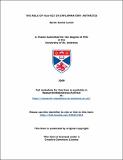Files in this item
The role of HLA-B27 in inflammatory arthritis
Item metadata
| dc.contributor.advisor | Powis, Simon John | |
| dc.contributor.author | Lynch, Sarah Janice | |
| dc.coverage.spatial | 312 | en_US |
| dc.date.accessioned | 2009-12-11T11:55:20Z | |
| dc.date.available | 2009-12-11T11:55:20Z | |
| dc.date.issued | 2009-11 | |
| dc.identifier.uri | https://hdl.handle.net/10023/834 | |
| dc.description | Electronic version excludes material for which permission has not been granted by the rights holder | en |
| dc.description.abstract | The MHC class I allele, HLA-B27, is strongly associated with a group of inflammatory arthritic conditions collectively known as spondyloarthropathies (SpA). Ankylosing spondylitis (AS) shows the strongest association with 90-95 % of patients being HLA-B27 positive. The relationship between HLA-B27 and SpA has been known for over 30 years, however despite ongoing research, the reason for this association has not yet been elucidated. In more recent years, research has focused on intrinsic properties of the HLA-B27 allele, in particular its propensity to misfold, forming homodimers. It has been proposed that these homodimers could be associated with the disease process through the activation of an ER stress response known as the unfolded protein response (UPR), or through aberrant recognition at the cell surface. We have investigated whether the expression of HLA-B27 is associated with the activation of the UPR. We have studied the expression of BiP, and the cleavage of XBP1 and ATF6 using stable and transiently expressing cell lines. We have also investigated the formation of non-B27 homodimers using a human cell line stably expressing HLA-B8, and finally we have studied the expression of homodimers in exosomes, small immunomodulatory vesicles released from numerous cell types. The results presented here lead us to conclude that in vitro studies of the UPR are complicated, prone to a number of technical issues, and may therefore not be appropriate for gaining information that would be of significant use when comparing to the real disease scenario. Our data suggest that non-B27 dimers may be strongly influenced by both the overexpression of MHC class I heavy chains and also the redox environment within the cell. We have isolated a novel fully folded, beta-2m-associated, MHC class I homodimer in exosomes and have detected a novel HLA-A and HLA-B mixed heavy chain dimer. Our results suggest that these dimers form through interactions between the cysteine residues in the cytoplasmic tail and that these dimers form in exosomes because they contain lower levels of the important antioxidant glutathione when compared to whole cells. Together, these results define a new MHC class I structure present on exosomes at significant levels, which could potentially influence immune recognition by both antigen-specific T cell receptors and NK family receptors. The data also poses questions about whether these novel structures, when they involve HLA-B27, could influence the pathogenesis of spondyloarthropathies. | en_US |
| dc.language.iso | en | en_US |
| dc.publisher | University of St Andrews | |
| dc.rights | Creative Commons Attribution-NonCommercial-NoDerivs 3.0 Unported | |
| dc.rights.uri | http://creativecommons.org/licenses/by-nc-nd/3.0/ | |
| dc.subject | Spondyloarthropothies | en_US |
| dc.subject | Ankylosing spondylitis | en_US |
| dc.subject | MHC class I | en_US |
| dc.subject | HLA-B27 | en_US |
| dc.subject | Exosomes | en_US |
| dc.subject.lcc | RC935.S67L8 | en |
| dc.subject.lcsh | Spondyloarthropathies | en |
| dc.subject.lcsh | HLA-B27 antigen--Pathophysiology | en |
| dc.subject.lcsh | Spondyloarthropathies--Genetic aspects | en |
| dc.subject.lcsh | Spondyloarthropathies--Pathogenesis | en |
| dc.title | The role of HLA-B27 in inflammatory arthritis | en_US |
| dc.type | Thesis | en_US |
| dc.type.qualificationlevel | Doctoral | en_US |
| dc.type.qualificationname | PhD Doctor of Philosophy | en_US |
| dc.publisher.institution | The University of St Andrews | en_US |
This item appears in the following Collection(s)
Except where otherwise noted within the work, this item's licence for re-use is described as Creative Commons Attribution-NonCommercial-NoDerivs 3.0 Unported
Items in the St Andrews Research Repository are protected by copyright, with all rights reserved, unless otherwise indicated.


